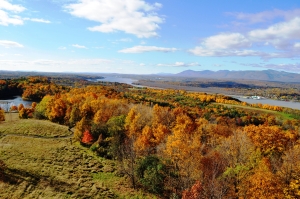A Petrified Delta 10-13-16
A Petrified Delta
Windows Through Time
Robert Titus
June 26th 2009
The Catskills present a number of public images. To many they are the land of Rip Van Winkle. We, in the Catskills, love the old story and retell it often. The plot seems to have been set right here on the Catskill Front. Other people immediately conjure up images of Borsch Belt hotels with their stand up comics. Then there are the images that were painted by the artists of the Hudson River School of Art. It really was here, in our Catskills, that a deep, artistic appreciation of a “sublime” landscape was born. We are all enriched by that view. Closely related to this is the great outdoors image of the Catskills, something that appeals to nearly everybody. Much of the spiritual side of what we call environmentalism comes from places like our Catskills.
But to geologists there is an altogether different concept of the Catskills. Not better, not worse, but very, very different! You see, there are thousands of feet of sedimentary rocks that make up the Catskill Mountains. It is mostly sandstone, along with a fair amount of shale. Throughout this vast thickness we find sedimentary features that we can identify. These reveal ancient environments petrified in the strata. They are fragments of ancient landscapes that have hardened into rock. We see original deposits with their original structures, and we can put names on them.
There are for example, throughout the Catskills, cross sections of ancient river channels. There are the deposits of old floodplains. We find ancient ponds and swamps. And so on. And when I say ancient I am not kidding around. These rocks range from more than 400 million years in age to about 350. That places them all in a time period that we call the Devonian.

Outlines of cross sections of Devonian stream channels at Plattekill Falls.
All of these petrified Devonian environments are typical of a great river delta. And again, I am not kidding around. These delta deposits are thousands of feet thick and stretch from the Catskill Front, in the Hudson Valley, to at least western New York State and probably a lot farther. That’s big!
All this has a name; it is called the Catskill Delta. Some would call it the Catskill delta complex. The latter emphasize that these delta deposits stretch for hundreds of miles south through the whole Appalachian realm. They have a point. This is not just a single delta, but a long complex of many deltas.
How did they form? Well, one thing is certain: every delta consists of heaps of sediment that were deposited when a river, big or small, flowed into a standing body of water, again big or small. Really big deltas form at the ends of really big rivers. The Mississippi River has a large delta. The Nile Delta is at the end of an equally long and large river.
But, you might ask “There are two problems: where did the really big rivers go? And, by the way, where is the body of water that it flowed into?” Those are good questions and they deserve, actually they demand answers.
Where did the rivers go? Well, that gets us to all that sediment. Big deltas need big sources for all their sand, silt and clay. The Mississippi has most of North America; the Nile has much of Africa. But back in the Devonian, North America was not very big and it could not provide much sediment. Instead our river, or rivers, flowed down the slopes of a great range of mountains, lying in today’s New England. These, called the Acadian Mountains, had, in fact, many streams flowing down their western slopes. All of them carried sediment out onto the great Catskill Delta. Those mountains eroded away long ago and their rivers are gone too.

Map of Acadian Mountains with delta rivers flowing off to the north.
. But what about that standing body of water? Where is that? The rivers of the Catskill Delta flowed across it and then entered something called the “Catskill Sea.” This is where it all gets very surprising. The Catskill Sea was a shallow ocean that stretched clear across all of North America. Beyond North America it merged with something that we would probably want to call the Devonian Pacific Ocean. In short, North America was a breathtakingly different place back in the Devonian.
All this gets us back to my original point. When a geologist has a good view of the Catskills, say from across the Hudson River, then what he or she looks at is a scenic range of mountains. What we actually see, however, is very different. We look up at the Catskills and see a petrified delta. If we could, we would treat it like

Petrified delta, viewed from Greene County. Rte. 81.
so many other specimens we find in the field. We would chisel it loose and bring it back to a museum. We would find a cabinet with a drawer labeled “fossil deltas.” We would put it in that drawer and keep it.
But it is too big for that. Better to enjoy it as it is!
Contact the author at titusr@hartwick.edu











